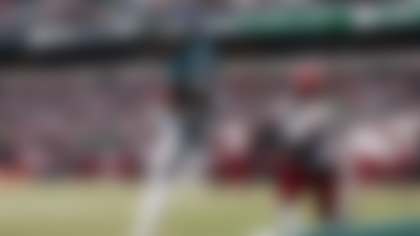The NFL hosted a call with members of the media on January 25, 2021 to discuss a new paper published by the Centers for Disease Control and Prevention (CDC) in their Morbidity and Mortality Weekly Report (MMWR) titled "Implementation and Evolution of Mitigation Measures, Testing, and Contact Tracing in the National Football League, August 9–November 21, 2020".
The paper discusses key lessons learned from the NFL's COVID-19 mitigation strategies, including elements that the CDC paper says can be broadly applicable throughout society to limit the spread of the virus, including "to settings such as long-term care facilities, schools, and high-density environments." More information on the paper and its implications can be found here.
SPEAKERS:
- Jeff Miller, NFL Executive Vice President overseeing Player Health & Safety
- Dr. Allen Sills, NFL Chief Medical Officer
- Dr. Christina Mack, IQVIA epidemiologist and advisor to the NFL
TRANSCRIPT:
Moderator: Thank you to everyone for joining us. We're certainly looking forward to Super Bowl Sunday with a tremendous match-up. We're also looking forward to spending about 20 to 30 minutes here talking about a piece of news. We'll hear from Jeff Miller here at the NFL, and then Dr. Sills, and Dr. Mack. After brief remarks from those individuals, we will take some questions and then we will wrap from there. You should have received reports as well as an abbreviated release from the NFL, so if you haven't received that, please let us know. We also have an on the line Megan Grant from our staff as well. Why don't we begin now with Jeff Miller.
Jeff Miller: Good afternoon everyone, this is Jeff Miller the head of Health and Safety and Communication here at the League and it's going to be my pleasure in a minute to introduce Dr. Allen Sills, Chief Medical Officer for the NFL, and Dr. Christina Mack who is a lead outside consultant to the League with IQVIA, who has been integral to injury collection information, as well as analysis as it relates to COVID and all on-field injuries.
We want to take this opportunity to talk a bit about the League's efforts over the last many months as we dealt with this pandemic and pursued playing our season. One of the principles that we started this season with was that anything that we were able to learn throughout the course of our regular season and postseason, we would then hope to share with public health officials and the public at large, should there be insights or learnings that could benefit people beyond football. We're aware that that we are a unique case in many ways, and our ability to test our players regularly, to have a defined population of coaches, players, and other personnel that work with our clubs in the League and be able to follow those people over defined set of days, weeks, and months. This has enabled us to identify some insights that we thought were worth sharing.
A lot of credit goes to our medical experts like Dr. Sills and Dr. Mack, as well as our clubs and their medical and training staff, as well as the players, the coaches, and other personnel themselves who have worked within a set of protocols unlike we've had to deal with in any other season. Lastly, let me add that we've sought out the Centers for Disease Control and Prevention (CDC) as a potential partner to identify and help and us analyze the information that we've seen, to make sense of it and see if it had applications for the broader public health community, especially in real time. As we have all navigated through this pandemic, the CDC has been terrific in terms of sharing advice with us, going back as far as before the season started, and then when we sought them out to have regular conversations throughout the course of our regular season in September through December, and now to work together to publish findings on the impact that our experience provided. We hope, as I said at the beginning, that our experience will have benefits for public health generally, and we're pleased that the CDC was willing to engage with us on it. With more specificity around this, let me turn it over to Dr. Sills.
Dr. Sills: Thanks Jeff and good afternoon everyone. I am pleased to spend some time talking with you today about this paper. I think that this is a significant achievement for the NFL and the NFL Players Association to partner with the CDC. We will highlight these unique observations that we made in our testing and tracing programs this season. We have to share credit for this work also, though, with the infection control officers, the head athletic trainers, team physicians and most importantly, our players, coaches, and staff, who have done the daily hard work of risk mitigation and protocol adherence throughout the entire season. Their cooperation and support has been foundational for us throughout the season.
I do think this work reflects tangible evidence of our ongoing commitment to use our data, our experience with this NFL season to benefit the public health response to the pandemic. As Jeff said, that was a priority for us that we identified early on; whatever we did, we wanted to make sure that we shared in a very transparent way with public health authorities at all levels, so that we can benefit from their input and so that our data and our experience could benefit others.
I think that this report is the culmination of a very active dialogue that we've had with the CDC throughout our season; as Jeff mentioned, we've been in regular communication throughout, sharing with them our plans. They really go all the way back to the NFL Draft last spring, when we were talking about how to stage that. And so we've remained in regular communication with the CDC and other public health authorities since that time.
I think that the paper really highlights the key features that have allowed our season to proceed, while minimizing the spread or transmission of this virus. One of those key highlights is that we were flexible and adaptable throughout. We've modified our protocols throughout the season based upon the data and the learnings we got from the testing and tracing programs. I think you see that reflected in this report in things like our evolving definition of high-risk close contacts and also the Intensive Protocol. I think we learned and reported in this work that all close contacts are not created equal. There are some contacts that convey a much higher risk, and circumstances really mattered. We've been able to evolve our understanding away from simple basics of six feet and 15 minutes, which is maybe where we all started back in the early days of the pandemic.
I think another important takeaway we had was that high-risk close contacts are avoidable. I think that you can see that directly reflected in the success of our Intensive Protocol where we reached a significant drop in those high-risk contacts. We were able to chart a path forward that allowed us to minimize those exposures and keep our teams safe.
Lastly, we were able to show that you can play a team sport while minimizing risk to the participants. It does require everyone to do their part every day. It also requires some modifications in certain activities. For example, the virtual meetings that we described in the paper and how those were an important part of risk mitigation.
I think those are a number of key themes that are pointed out in this work. Again, I want to share the pride of authorship with our colleagues at the NFL Players Association and certainly with our team medical staffs, infection control staff, and our players, coaches, and staff that did the hard work each and every day throughout the season. And with that, I'll pass it over to my colleague, Dr. Mack.
Dr. Mack: Hi, thank you everyone, this is Dr. Christina Mack with IQVIA, an epidemiologist that has worked closely with the NFL, the NFLPA, the CDC, and our other experts this season. As you've read in the manuscript, this season we embarked on writing the protocols with an incredible amount of thought and scientific rigor put into the protocols that governed the season. As part of that, a significant amount of data was generated over the course of the season, which then generated a meaningful amount of evidence that can help guide not only the NFL, but also broader public health efforts which we see in this paper.
Over the course of the season, there were more than one million COVID-19 test results. There was substantial amount of wearable data from proximity devices and contact tracing, and there was also a robust amount of interview data that came from contact tracing interviews from every case. Contact tracing in the NFL was innovative and evolved throughout the season. It had two components. One was preventative, there was a rigorous effort on the part of every NFL team, as well as the League and the PA, to ensure that contacts were minimized and the teams were rigorous in terms of compliance with behavior and protocols, masking, distancing, throughout the season. And second, contact tracing was an imperative piece of "action-ing" the positive case and preventing spread, which is what the CDC paper really highlights.
Anytime there was a positive case during the season, it opened up a new case file, and a "SWAT team" was assigned to that positive case to trace it in a rigorous manner from start to finish, using all the data that we had at hand. Through this process, we really developed a learning ecosystem where we were analyzing data at every point, evolving the protocols. As you see in the paper, ensuring that their learnings were brought in to continuously make our protocols stronger and stop transmission. One of the key learnings that we found that we're able to highlight in this paper, starts with the re-definition of contact tracing. While we always focus on time and distance, [we also focused on] masking – that includes whether or not individuals wear masks, as well as the type of mask (whether it was medical grade vs. cloth face covering) – as well as ventilation and air flow. Our contact tracing efforts, and evidence generated from those, were absolutely critical in being able to action out each case, through contact tracing. Throughout the course of the season, whenever there was an individual that was deemed a high-risk contact of a positive case, that individual was isolated, quarantined for five days, and the team was put in the Intensive Protocol. And those two interventions together were instrumental in keeping the season going.
Moderator: Thank you Dr. Mack, thank you Dr. Sills. At this point, let us know if you have any questions and we will begin the Q&A portion.
Question: Hi, guys, thanks for taking my question. I have a question about the actual number of tests. My understanding is that there are 623,000 tests in the August 9th to November 21st period. I did some quick math, and I think that's half a percent of all U.S. tests in that time period, to test only 11,400 players and staff. Can you speak as to what your thoughts are on if that's an appropriate use of that number of tests, given where the pandemic was in the country at that period of time?
Dr. Sills: The appropriate, accurate deployment of tests is an issue that we've considered since the very start of our discussions around the pandemic. Again, dating way back into the spring, the NFL and the NFL Players Association together looked at how we can create the safest possible environment. One of our foundational principles is, not only did we want to support the public health efforts, we also didn't want to do anything that would in any way damage or deter public health efforts. We had regular and ongoing conversations and raised exactly around the question that you just asked, which is, is there an adequate testing supply that we can use to deploy in a manner that we think is safest for our players, coaches, and staff?
As we thought about the schedule that we would use, we discussed a number of different scenarios and models, we eventually evolved to a daily testing regimen as we've outlined. But in doing so, we set up a completely independent supply and logistics pipeline. At no time during the entire season, did we go and pursue testing with any healthcare agency or existing hospital because we thought it was extremely important that we not do anything that interfered with the care of patients and with the overall public health response.
Our testing program was set up through an independent laboratory company with new supply and new distribution methods. We constructed a laboratory at our own team facilities, and we continued to ask those questions throughout, which is: are we doing anything that would hinder the public's availability of tests? When I say that we asked those questions, we didn't just ask them to ourselves. We asked those questions to public health authorities, we had regular ongoing dialogue with the White House Task Force, with the CDC, with the FDA, with others. And we asked them that very question. We received positive feedback that our testing program was not interfering with healthcare needs at that time. So that's been a foundational principle for us from the start.
And I think on the flip side, as we mentioned before, through the efforts of our testing program, we've been able to accumulate a substantial amount of data that really showed a snapshot into detection and transmission that otherwise would not have been possible. We essentially have a real-world look at 32 different communities that have been followed over a six-to-seven-month period of time, and that data simply doesn't exist anywhere else. And because of the richness of that data, it allows us, the CDC and others to really hone-in and understand not only transmission but more importantly risk mitigation.
Question: Thanks so much for doing this again. I think one of the questions that all of us had before this season started was how you could play a contact sport where people were in such close contact with each other and multiple teams. I guess, first, is there any evidence at this point of any on-field transmission and if that was not the case, why do you believe that did not happen and what are maybe the broader lessons about how we can play sports moving forward -- whether that's high school football, basketball, softball or any other sport?
Dr. Sills: I can start and then toss it over to someone else. So once again, it is correct that as of today we have not seen any evidence of on-field transmission in NFL games or practices. Part of what gives us confidence with that statement is not only just our case reports, but the proximity tracking data that we have and the genomic epidemiology data that we've been doing where we look at the genetic lineage of each positive case so we can try to identify how it might have spread from one person to another.
We did not see any evidence that the virus 'crossed the line of scrimmage,' so to speak. And I think that is an important observation; it's certainly a question that many people raised before we started. As to why that occurred, I think there are a number of theories that people have advanced; one of them is that, obviously, we are playing either in in an open air – or extremely large-air environment – where we have a lot of ventilation, a lot of movement and lightning-quick dispersal of any kind of droplets or particles.
Secondly, the proximity tracking data gathered by the KINEXION devices that all our players, coaches and officials wore on the field showed that in the course of a game, there's actually very little interaction overall, cumulatively, in close proximity between players. I know that may seem a bit paradoxical because you think of people lined up across the line of scrimmage or tackling each other, but when you sum out all of those interactions, it actually turned out to be a very brief period of time in the context of some of the other interactions we've seen.
And then I think the third reason is that our protocols were obviously set up to try and prevent infected individuals from being on the field. Obviously there were some cases where people who - unknown to us - were infected, but those were still a fairly small number of cases, so since we employed a very wide net of trying to detect those cases, we simply didn't have as much exposure on-field, which is one of the things we had hoped to avoid. Those are my thoughts – I'll toss it to Christina or Jeff and ask if they want to add anything.
Dr. Mack: Absolutely, I think when we really look at the data and look at what we were able to say in the paper, one thing that shines through and answers that question is: context matters. Football is played in a well-ventilated area, there's a lot of airflow. Brief interactions and the way that the protocols were set up reduced a lot of the things on the sidelines where we might see transmission. So, with a football game, we had a lot of that context taken care of in terms of good ventilation and airflow and very short amounts of interaction between people on the field. Another really important thing to think about is that, again, the way these protocols were set up, individuals were tested very frequently and that's given us a lot of positive individuals and a lot of ones who've had a high-risk exposure to a positive individual – they were not allowed out on the field.
Question: This is for Dr. Mack. As you were going through the contact tracing process, were there any tangible examples you could give us that show what you were able to find that teams, players, and coaches were doing unbeknownst to them that was increasing their risk -- and were you able to get that straightened out?
Dr. Mack: We talked at the beginning of the call about the evolution of the protocols. At every turn, we were generating data, and at every turn we had learnings that we were working back into the protocol. So, it was a learnings ecosystem. And one of the big things that we changed – which answers your question – is the launch of this Intensive Protocol, which essentially took our standard protocol and added an additional, protective layer on top of it. So, the things that we took into that Intensive Protocol are the things that we observed where we know that there was transmission, and so we wanted to look into that.
So, an example of that are meetings and spa-rooms in-person where even if you're at six feet of distance, the ventilation is not there to prevent transmission of the virus. Eating and drinking together, driving together in cars, eating a meal in small gathering areas and proximity within locker rooms – all of those things are where we saw vulnerabilities for transmission of the virus and were we worked into the Intensive Protocol that extra layer of protection.
Question: Any advice you would give to, say, long-term care facilities or schools? What from that information do you think would be most beneficial outside of the league to things like long-term care or schools?
Dr. Mack: One of the things that we have discussed with the CDC as well as our group of experts as we've gathered the data and used it to adopt protocols is: Where can this be applied externally? And there are many places it can be applied externally. You mentioned long-term care facilities - we talked about those and other essential businesses such as manufacturing facilities, who do not always have the ability to shut down even when there is a positive case.
So, places that could be moved into something like an Intensive Protocol, repurposed to fit that environment: things like closing break rooms, reconsidering any in person meetings, moving as much as possible to virtual, further restricting access or lowering numbers into specific meeting rooms or specific areas to, again, ensure that that ecosystem or community has one more additional layer of protection.
If an individual has had high-risk exposure, that exposure can be evaluated by looking not just at distance and time, but also at masking and ventilation. If we can identify individuals that have had a high-risk exposure and quarantine them for an appropriate amount of time, that process – both the contact tracing and the quarantine – can protect that community.
Dr. Sills: I would just add that along those lines, it's important to recognize that what our work shows is that the most impactful interventions were not those that were high-resource, such as daily testing or proximity tracking devices. The most impactful interventions are things that can be applied anywhere, no matter resources – just things such as universal use of face masks, moving meetings outside or minimizing the amount of in person meetings, closing dining rooms, offering only to-go food options, strictly enforcing quarantine after exposure. Those things all have broad applicability beyond football including, for some of the settings you asked about such as schools and nursing care facilities.
Question: You kind of started answering the question I was going to ask. You talked about sharing lessons with the public, youth sports and high school sports -- What would be the top two tips that you would give coaches and administrators to ensure that they are able to make their season a success like the NFL?
Dr. Sills: You go back to the basics we talked about – the basics of the game, the fundamentals like blocking and tackling. For us, the basics are things like universal mask usage, having as much outdoor activity as possible, minimizing the amount of in-person, indoor meetings, face coverings at all times (that includes things like weight rooms and other aerobic activities where people have often questioned whether you can or should need those masks), prompt reporting of symptoms, and isolation of those individuals who might have symptoms. We've seen and said repeatedly that the virus only needs a very small opening to spread into the team environment. So, I think again those are lessons that can be applied at any team sport at any level, but it simply takes a daily sustained commitment from each and every person and an acknowledgement and understanding of what are these higher vulnerability activities and a strict avoidance of those to keep everyone safe.
Question: You sort of said this several times and you mentioned it again today that you wanted to provide an example of how this could be done, how a sport could operate safely, how a business could operate safely. As you look forward now into the vaccine phase, how do you think that applies going forward to sort of, setting the example as you move to having vaccine availability for your personnel?
Jeff Miller: The first way we're interested in talking about vaccines are in the two things we've shown already. One is to extend the invitation to 7,500 vaccinated healthcare workers to attend the Super Bowl, which hopefully is an acknowledgment of the level of gratitude that we all feel to people who've been on the frontlines in helping our communities through the pandemic. I'm pleased that announcement has gotten a fair amount of attention, and I'm hoping that continues to grow to the Super Bowl because these people deserve nothing less.
And, secondly, hopefully it illustrates the value of vaccinations. It will be vaccinated healthcare workers who will be attending this game, and hopefully it adds to the conversation that people are having in their communities about the importance of getting vaccinated as we look forward to 2021.
The other aspect of that is that we're really pleased that some of our clubs have been able to share their stadiums with the local community as vaccination centers and more are inclined to do so as time goes on and the vaccination rollout increases. To the extent that our clubs and their communities can use our facilities and volunteer to help get the community vaccinated, we think that that is a great example of a way that we can contribute and give back, and it's our responsibility to keep doing that going forward.
Where we go from there, as we get towards the off-season and next steps? We're in regular discussion with the new administration and, as you can tell, we're having ongoing conversations with the CDC which are hugely beneficial. We look forward to other ideas for how to contribute to the conversation around vaccines. Allen? Anything you want to add to that?
Dr. Sills: No, I think it's all well said. I think you've also heard us say repeatedly that we don't feel that we want to cut the line in terms of moving forward with prioritization of vaccination. We believe that the priority and order for vaccination should be determined by government officials and public health authorities, and we're going to support that. And when it's the appropriate time for our players, coaches and staff, we'll obviously engage in a very active discussion about that. We believe very strongly in the vaccine: we think that it's safe, it's effective and we encourage everyone to get vaccinated. We think that it's an important aspect of moving forward through this pandemic and we'll do all that we can both individually and collectively to support vaccination efforts all across segments of society.
Question: Just wondering with all the data that you have – and you've done a great job of protecting people on the staff – centered around the Super Bowl, how did this report help you prepare for the fans? Is there going to be game-day testing? What other measures are you taking to make sure that your fans there are safe when they come and leave?
Jeff Miller: Let me offer a couple of stats off the top, which could provide some value to this and then I'll turn it over to the true experts.
I think that at this point in the season, we've now welcomed more than 1.2 million fans into our stadiums around the country – more than 100 games have hosted fans including the two games yesterday, and I think that the protocols that Dr. Sills, the public health community, and certainly the local communities have been able to put together have been able to keep those fans safe.
Obviously, masks are essential. Distancing, the pod concept that had been used, the really good enforcement of mask wearing and some of the other measures that were put in to place - including obviously limiting the number of fans in the stadium - have provided that. As we look toward the Super Bowl, the same process was undertaken with local health officials and a fair amount of detail going into endless schematics of how we were going to put fans in the stadium. Again, with mandatory masks, with social distancing and with the really cognizant acknowledgement that we were going to limit the number of fans that were going to be able to attend to ensure the health of the fans there.
In addition, the 7,500 vaccinated healthcare workers were taken into account when looking at the total number of fans in the stadium, but even then, we wanted to make sure that we didn't disturb the concept of the pods, the fans sitting together, being able to enjoy the game safely. So, it's been a lot of work by a lot of people and a lot of engagement with local and state and national public health officials to do this and do it as safely as it can be done.
Dr. Sills: Just a couple of thoughts to add, as we have always said, our top priority is to create the safest possible environment for everyone who is present but also, we take very seriously our responsibility to model best behavior and to show how we believe one can safely conduct an event of this magnitude. So, as Jeff mentioned, we reviewed these plans in great detail, not only with local public health authorities, but with a number of federal public health authorities. We shared them with the incoming administration's coronavirus taskforce, we shared them with the CDC and other groups, saying: This is what we plan to do, please help us fine tune and make this as safe as it possibly can be. So, we have a number of plans in place, again, a very detailed plan. Every fan who is in the stadium - whether vaccinated or unvaccinated - will be wearing a KN-95 mask (we're supplying them). We have very strict protocol about pod integrity, about the spacing, the inflow, the outflow, the use of sanitization, the use of contactless methods.
So, all of those are things we've learned throughout the season as Jeff mentioned in the places we've hosted fans. It's also important to note that we've not traced any outbreaks or cluster of cases to any of the places we have hosted fans, so that's an important measuring stick for us. Modeling the best behavior at all levels is something that we think is very, very important.












